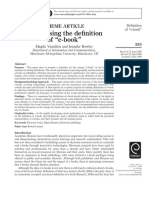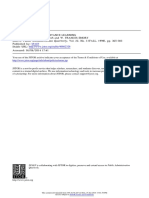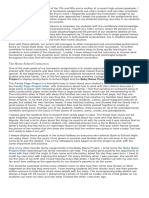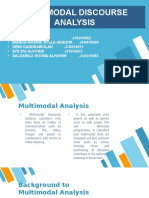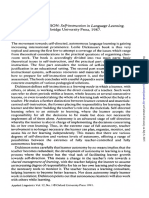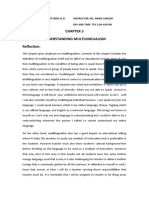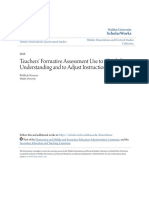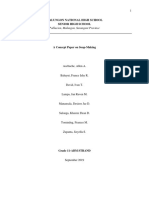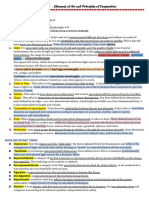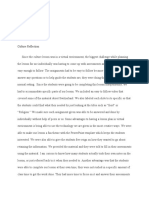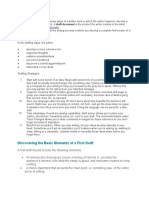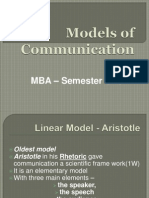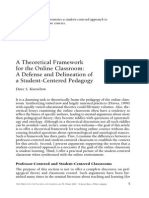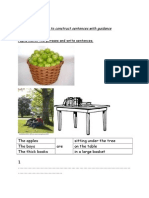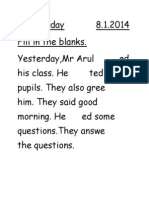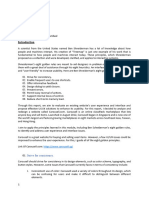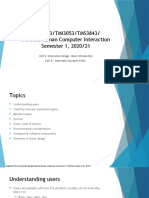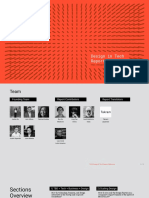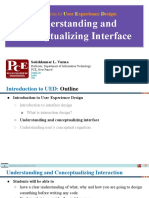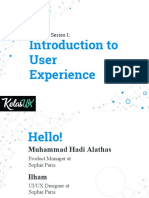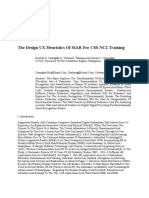MOOCS and Applied Learning Theories
MOOCS and Applied Learning Theories
Uploaded by
prakash76Copyright:
Available Formats
MOOCS and Applied Learning Theories
MOOCS and Applied Learning Theories
Uploaded by
prakash76Original Description:
Original Title
Copyright
Available Formats
Share this document
Did you find this document useful?
Is this content inappropriate?
Copyright:
Available Formats
MOOCS and Applied Learning Theories
MOOCS and Applied Learning Theories
Uploaded by
prakash76Copyright:
Available Formats
MOOCS AND APPLIED LEARNING THEORIES
MOOCSandAppliedLearningTheories
MatthewMarsaglia
WilliamKemp
SamuelJefferson
ClaireBradley
EvanSilberman
MOOCS AND APPLIED LEARNING THEORIES
EmergingLearningTheoriesandMOOCS:SocialConstructivismtoConnectivismEvan
Silberman
AprecursortoMOOCSisonlinelearning.Onlinelearningiseducationinwhich"Theteacher
andthestudentareseparatedgeographicallysothatfacetofacecommunicationisabsent
communicationisaccomplishedinsteadbyoneormoretechnologicalmedia,mostoften
electronic"(Guthrie,2003).Thereisdifferenttypesofonlinelearningfromthetraditionalclassroom
withsupplementary,webbased,materialonline,toahybridcoursewheresomelearningisdigital
andsomeisphysicallylocated,tofullyonlinecourseswithnophysicalclassroomtospeakof.
OnlinelearningisanappropriateplacetostartthediscussionaboutMOOCsandSocial
Constructivism,becausethegenesisofMOOCSisdistanceeducation,andaniterationofonline
learningistheMOOC.Infact,manyMOOCplatformshavesimilarfunctionalityatleastfromthe
studentperspectiveasatraditionallearningmanagementsystem.Toolssuchasdiscussion
forums,instantmessaging,videos,andotherinteractivetoolsarecommon.SomeMOOCfeatures
arealsoreminiscentofWeb2.0environmentsthatarethefoundationofmanyelearningsystems.
Technologycontinuestopushelearningandhighereducationboundariesfurtheras
computerandinternetaccessexpandsglobally,highernetworkbandwidthenablesricher
educationalexperiences,andtheemergenceofsocialnetworkingintroducesgreaterengagement
amongcourseparticipants.AnoutgrowthoftheseadvancementsistheMOOC,anemergingmodel
fordeliveringlearningcontentonlinetoanunlimitednumberofstudents(Pirani,2013).The
transformationofelearning,theshiftfromresidentialtodigitalcampuses,andtheemergenceofthe
digitalnetworksareimportantfactorsforMOOCs.TheMOOCprovidesawayforUniversitiesto
2
MOOCS AND APPLIED LEARNING THEORIES
extendtheirreach,whileeducatinghundredsofthousands.IfMOOCSareatransformationin
elearning,howhasonpedagogyandlearningtheorieschangedtokeeppace?Whatlearning
theoryismostapplicabletotheMOOC,andwhat,ifanylearningtheoryisemergingasaresult.
TherearetwolearningtheorieswhosecharacteristicsmatchtheMOOCenvironment,Points
ofViewingTheory,andConstructivism,especiallySocialConstructivism.Boththeoriessharethe
commonalitylearningwithothers,andthroughthelensofothers.
SocialConstructivismisatheoryinwhichgroupsconstructknowledgefromoneanother,
collaborativelycreatingasmallcultureofsharedartifactswithsharedmeanings.Itisbornfrom
constructivism,atheoryoflearningwhereknowledgeisconstructedbythelearner.Thebasicidea
isthatproblemsolvingisattheheartoflearning,thinking,anddevelopment.Aspeoplesolve
problemsanddiscovertheconsequencesoftheiractionsthroughreflectingonpastand
immediateexperiencestheyconstructtheirownunderstanding.Learningisthusanactiveprocess
thatrequiresachangeinthelearner.Thisisachievedthroughtheactivitiesthelearnerengagesin,
includingtheconsequencesofthoseactivities,andthroughreflection.Peopleonlydeeply
understandwhattheyhaveconstructed(Guthrie,2003).OneofthekeycontributorstoSocial
ConstructivismisVygotsky.OneofVygotskycoreconceptsistheZoneofProximalDevelopment
(ZPD).Inbrief,theZPD,arethelimitsoflearningthatanindividualiscapableofwiththehelpof
others.Itisthejoboftheinstructorfacilitatortostandinthegapthezoneofproximaldevelopment
andtocreateasocialcontextthatwillpullstudents...totheirpotential(Asin...Angela,2013).
Dulen,inherarticleSocialConstructivismandOnlineLearningEnvironments,talksaboutthe
limitationsofonlinelearningenvironmentstosupportSocialConstructivism.Herargumentisthat
socialconnection,andsociallearningismostlybodylanguage,whichisdifficulttofacilitateonline,
MOOCS AND APPLIED LEARNING THEORIES
especiallyforcoursesdesignedwithoutintenttowardSocialConstructivism.Theresponseisto
createhybridorblendedlearninginwhichlearningispartlyonlineandpartiallyfacetoface.
Infact,DulensarticlewasoneofveryfewthatexaminedonlinelearningfromaSocial
Constructivistperspective.TheconclusionisthatSocialConstructivismisalensthroughwhichone
canviewonlinelearning.Thecontentofthearticlesuggestthatonlinelearningisntnecessary
constructivist.Rather,howthecourseisdesignmakesitso.
InPointsofViewTheory(POVT),Learnersactivelylayertheirviewpointsandtheir
interpretationstoelicitpatterns,themes,andgroupsofideasthatleadtoadeepunderstandingof
thecontentunderinvestigation...(Goldman,Black,Maxwell,Plass,&Keitges,2012).Inother
words,POVTaddressesthechallengesofaglobalsocietybyhelpingindividualscapitalizeon
othersperspectives.POVTiswidelyapplicabletolearningmedia.Inparticular,Goldman,etal.
discussperspectivitytechnologiesthatprovideaplaceandspaceforbuildingculturesor
communitiesofpracticewhereonecatchessightoftheotherwhileparticipatinginlearning.
POVTinessenceisaboutsharedlearning.
MOOCSareanecosystemthatpromotessharedlearninginamassiveform.
AlthoughSocialConstructivismandPOVTholdsomeapplicabilitytoMOOCSbasedontheir
generaldefinition,anddefiningcharacteristics,thereislimitedresearchtosupporthowapplicable
thesetheoriesaretoMOOCS.Infact,inaSystematicStudyofMOOCliteraturefrom20082012,
themajorityofarticleswereprimarilyconcernedwiththeconceptofMOOCS,discussing
challengesandtrends,whileotherthemesgenerallyappearedwithinonlyonepaperexceptforthe
conceptofconnectivismanditsimplications(Liyanagunawardena,Adams,&Williams,2013).In
theresearchforthissectionofthepaper,theexperiencewassimilar.Withtheexceptionofone
MOOCS AND APPLIED LEARNING THEORIES
article,therewaslimitedinformationaboutlearningtheoriesandMOOCS,again,exceptfor
connectivism.ThediscussionaboutMOOCsappearstobefocusedonanunderstandingof
MOOCS,andtheimpactonhighereducation.Therecurrenceofconnectivismsuggestsanew
learningtheoryisemergingforMOOCSworthexploring.
First,itisimportanttonotethatconnectivismappliestooneofseveraltypesofMOOCS,the
cMOOC.OtherMOOCtypes,suchasthexMOOCarewithoutapedagogicaltreatment.The
cMOOCisaresultofConnectivism.ConnectivismisanewlearningtheoryintroducedbyGeorge
Siemensin2004inordertocopewiththeincreasingcomplexityandfastpacedchangeofthenew
knowledgeera(Chatti,Jarke,&Quix,2010).ThemostcommonexampleofacMOOCisthefirst
MOOCevercreatedbySiemensandhiscolleagueStephenDownescalledConnectivismand
ConnectedKnowledge2008(CCK08).IncMOOCs,thelearnerstakeagreaterroleinshaping
theirlearningexperiencesthaninatraditionalonlinecourses.,whilefacilitatorsfocusonfosteringa
spaceforlearningconnectionstooccur(Milligan,Littlejohn,&Margaryan,2013).
ConnectivismwascreatedbySiemensbasedofthebeliefthatcurrentlearningtheories
didntaddressthecharacteristicsofWeb2.0.ThatisTherapidgrowthofknowledge,whichmakes
knowledgeitselfadynamicphenomenonthenewkindsofproductionandexternalizationof
knowledge,whichmultiplytheperspectivesembeddedinknowledge(Milligan,etal.2013).
Connectivismcontrastbehaviorism,cognitivism,andconstructivism,whichoperateonthepremise
thatknowledgeisconstruction,andobjectstothinkwitharecreatedasanoutcomeofconstructing
thought.InConstructivism,thereisnoartifactperse,andknowledgeisdynamic.
Siemens(2005,2006)andDownes(2005,2012)summarizedtheexisting
learningtheoriesinthreetheoreticalpositions:behaviorism,cognitivismand
MOOCS AND APPLIED LEARNING THEORIES
constructivism.Theyassumedthatthesethreepositionssharetwokeyattributes:(a)
knowledgeresidesintheindividualand(b)knowledgeisathingarepresentationthat
peoplecreateorappropriate.SiemensandDownesarguedthatthesetwoattributesarenot
compatiblewiththecharacteristicsofknowledgeinWeb2.0.Intheirview,thedynamismof
knowledgeinWeb2.0contradictsthethingnessofknowledgeassumedbytheexisting
learningtheories,andthemultiplicityofperspectivesembeddedinknowledgeinWeb2.0
contradictstheindividuallocationofknowledgeassumedbytheexistinglearningtheories
(Milligan,etal.,2013,p.130).
Therefore,ConnectivismaddressesthechallengesposedbyWeb2.0forlearning,andisadopted
tothecMOOCbasedonfourlearningactivities:aggregation(sometimesreferredtoascuration,
accomplishedthroughaninitiallistofresourcesontheMOOCwebsiteandthenaddedtothrougha
dailynewslettersenttoallparticipants)remixing(wheretheconnectionsaremadeand
documentedthroughblogging,socialbookmarking,ortweeting)repurposing(oftenreferredtoas
constructivism,inwhichlearnersthencreatetheirowninternalconnections)andfeedingforward
(thatis,sharingnewconnectionswithothers)(Yeager,HurleyDasgupta,&Bliss,2013).Inother
words,learningincMOOCsisbasedonnetworks.InthetruesenseofMOOCsitisdesignedfor
anyonewhoisinterestedinlearningaboutsomethingnew.Unlikethetraditionalschoolmodelofan
instructorinthefrontoftheclassroom,knowledgeisshared.TheMOOCactsasanenvironmentin
whichnewformsofdistribution,storage,archiving,andretrievalofferthepotentialforthe
developmentofsharedknowledgeandformsofdistributedcognition(Yeager,etal.)
MOOCS AND APPLIED LEARNING THEORIES
However,isConnectivismenoughtosupporttherapidadoptionofMOOCs?Doesasingle
learningtheorydefinethefutureoftheMOOC?Willneweducationaltheories,andpedagogical
approachesemerge?Connectivismaddressesthechallengesposedbyweb2.0forlearning,but
thepracticeofConnectivismhasfrictionwithitsonlinecounterparts,ourcultureandtendenciesof
Internetuse,andprinciplesadvancingwebUXdesignandthetranslatingConnectivisminto
successfuldesign.InthenextsectionofthepaperMOOCS,Connectivism,andUXdesignis
explored,especiallyinthecontextofgames,whichweposithavesuccessfullyimplementedUX.
MOOCs,andarestillanewconcept,andtheevolutionoftheMOOCisunclear.Whatis
clear,isthatadditionalresearchisnecessaryabouteducationaltheoryandMOOcs.Itisnotenough
toaspects,concepts,examples,ortechnologyofaMOOC.ForMOOCsbeeffectiveforlearning,a
betterunderstandingofhoweducationaltheoriesandtheirapplicabilitytoMOOCsisneeded.Or,
similartoConnectivism,anewparadigmisrequired.Thesilverlining,eitherway,isthatthepower
liesinthehandsoftheeducator,technologist,andevenstudentinfluenceanewpathwayfor
learninginaMOOC.
Asapproachestoeducationshift,studentsarerelyingmoreontheInternet,notonlyfor
informationforcoursework,butfortheirsocialcommunication,culturalknowledge,andmodesof
expression.Alloftheseinteractionsinfluencethewayeachstudentapproachestheeducational
environment,whichislargelyatoddswithitsonlinecounterpart.
LiviaVeneziano,UXDesigner
UXAffordancestoInformHybridMOOCDesign
TheInternationalOrganizationforStandardizationdefinesuserexperienceas"aperson's
MOOCS AND APPLIED LEARNING THEORIES
perceptionsandresponsesthatresultfromtheuseoranticipateduseofaproduct,systemor
service."Thefieldofuserexperience(UX)isrootedinthebehavioralsciencesespecially
ergonomics,psychology,andhumanfactorsandconsidersallaspectsoftheenduser's
interactionwithaproduct,serviceand/orbrand.Increasinglycompetitivemediaandecommerce
industrieshaveemphasizedaneedfordigitalenvironmentsthatencourageuseradoptionand
profitablebehaviors.AmajorityofUXprofessionalsareactiveinthissegment,and,consequently,
UXprinciples,whichfocusonutility,consistency,efficiency,easeofuse,andemotionalresponse,
havelargelyevolvedoutofbestpracticesinthecommercialsector(Disaboto,2012).
Aconsiderablechallengetheseprinciplesareappliedtoistranslatingcomplexprocesses
intohospitableonlineinteractionsmovingtowardatransaction.Theseexperiencesareoften
presentedbyreducingcognitiveloadtoenablefrictionlessconsumption.Criticalthinking,forthe
mostpart,isnotencouraged.Twotopsellingbooksonusability,DontMakeMeThinkand
RocketScienceMadeEasy,illustrateapreoccupationwithsimplicity.MassivelyOpenOnline
Courses(MOOCs),whichofferhighereducationcoursestotensandhundredsofthousandsof
onlineparticipantsfromdifferentlocationsandvaryingbackgrounds,isacomplexoperationthat
canbenefitfromUXprinciples.However,deeplearning,wherelearnersareengagedattheouter
edgeoftheircompetenceisnoticeablyatoddswithUXprinciplesofsimplicity,efficiencyand
easeofuse.Learningissometimesnotsimpleorstreamlinedsometimesitisastruggle.In
comparison,videogames,MOOCscohortineducationalmedia,strivetomakegamesthatare
pleasantlyfrustrating,nottooeasyastoboretheplayerandnottoodifficultastogeneratefeelings
ofincompetence.Injuxtaposition,itisdifficulttoimaginewebenvironmentsencouragingpleasantly
frustratingthroughUXdesign.Nevertheless,perhapstheBrowserhassomethingtolearnfromthe
MOOCS AND APPLIED LEARNING THEORIES
Boss.IfMOOCsaretodevelopintoeffectiveconduitsforlearningandfavorablyseparate
themselvesfromaconsumptionheavyonlineculture,wheredoesUXandgamedesignfitin?
InthischapterIhypothesizethatxMOOCshaverealizedgreateruseradoptionandfunding
becausetheUXprinciplestheyupholdnamelypathlengthandguidancepresentmorefeasible,
scalableandindemandoptionsthancMOOCs.IalsoarguethatxMOOCshaveleveraged
behaviorismsfundamentalbeliefinuniversaltruthstoincorporateelementsofgamedesign(most
notablyWellOrderedProblemsandCyclesofExpertise)inawaythatcMOOCshaveyettoadopt
intheirownterms.Ultimately,thischapterisinanefforttoconsidereffectivexMOOCpracticesin
contrasttocMOOCssoastoinformthedesignofahybridMOOCthataccommodatesalarger
audienceandprovidesanengaginglearningexperienceonthelevelofcurrentvideogamesfor
learning.TobetterunderstandthetwoMOOCvarieties,acomparisonofcMOOCsandxMOOCs
willbeginthechapterandwillbefollowedbyanidentificationofUXprinciplesinxMOOCsandtheir
relationtolearningprinciplesaffordedbyvideogames.Lastly,thechapterwillconcludewithalook
atconnectivismssocialfocus,andhowitstroubletranslatingtoanadoptedpracticepresents
opportunitiesforUXandgamedesignsolutions.
MOOCVarieties
MOOCshavepredominantlybeenpresentedintwoforms:xMOOCsandcMOOCs.George
Siemens,apioneerofconnectivistlearning,summarizesthepolarity:cMOOCsfocuson
knowledgecreationandgeneration,whereasxMOOCsfocusonknowledgeduplication
(Mackness,2010).cMOOCsaregroundedintheconnectivistlearningtheory,whichpositsthat
learningistheresultofmakingconnectionsatthesocial,conceptual,andneurallevel.cMOOCsare
MOOCS AND APPLIED LEARNING THEORIES
characterizedbyalackofstructureandfocusonlearnersexploringawideswathofmaterialontheir
own(Kopetal,2011).Conversely,xMOOCsaregroundedinbehavioristlearningtheoriesandare
highlystructured,focusingoninformationtransmission(Clow,2013).
Thetwomodesdifferfurtherbyhowtheircurriculumandassessmentispresented.xMOOC
curriculumislinear,andcoursecontentisdeliveredthroughvideolecturesandcomputergraded
assignments.Assessmentistypicallypresentedintheformofmultiplechoice,matching,and
fillintheblankquestionsthatinterjectalectureorstandaloneasaquiz/exam.
AlthoughsomecMOOCsoffervideolectures,amajorityofcMOOCsareproducedbyindividuals
andgroupsthatcannotaffordvideoproductioncosts(xMOOCs,suchasCourseraandUdacityare
forprofitcompaniesfundedbyventurecapitalists,AndressenHorrowitzandCharlesRiverVenture,
respectivelyEdXissupportedbyHarvardandMITscombined$43Bendowment).cMOOC
learningresourcesaretypicallyonlineessays,articlesandblogpoststhatarepresentedwithout
guidingprompts,ineffect,fosteringaspaceforlearningconnectiontooccur,andrelyingonthe
learnertotakeagreaterroleinshapingtheirlearningexperiences(Milligan,2013).Assessment,if
enacted,istypicallyconductedbypeersorcoursemoderators.
WhilecMOOCsseelearningasanopenendedprocessthatisexperienceddifferentlyby
eachperson,highvalueisplacedoncontributingtoadomainsongoingglobaldialogue.
Connectivismseestheevolutionofadomainasdirectedbyconversationsonthemattercurrent
domainknowledge,then,isanunderstandingofbothadomainscurrentstateanditsprojected
trajectory.Theseobservationsandforesightsrequireactivelisteningtoandmeaningmakingof
theseconversations.Althoughresearchhasshownthatthetypeofcollaborativemethodsof
instructionenactedbycMOOCsaremoresupportiveoflearning,thesignificantproduction,
10
MOOCS AND APPLIED LEARNING THEORIES
useradoptionandfinancialsupportrealizedbyxMOOCsappearstorepresentaninstructional
preferencebacktobehaviorism.MOOCsarearelativelynascentlearningplatform(thefirstMOOC
washostedin2008),andsuchashiftmayrepresentapreferencenotforbehavioristinstruction,
behindthexMOOCplatform,buttheuserfamiliarityandfeasibilitytheframeprovides.
Paths,Flow&FeedbackUX&GameDesignAspectsAffordedinxMOOCs
Theseriesofactionsausertakestoaccomplishataskonlineisconsideredonepathofthetotal
pathsviablebyawebsitesmechanicsandpotentialusecases.Theeasier(quicker,lesschoice
involved)thepath,themorelikelytheuseristonotonlybesatisfiedwiththeirexperience,butto
alsoreturntothesiteforsimilaranddifferenttasks,becauseofanestablishedconfidenceinthe
sitesmechanicsandnavigability(Disaboto,2012).Whendesigningonlineenvironments,thereisa
UXefforttolimitthenumberandlengthofpaths,becauseiftherearemanywaystobeginan
interaction,thenyouautomaticallyhavetosupport,andaccountfor,thosemanydifferentuse
cases.Itmakessensetosimplifythenumberofpathsasmuchaspossible,sotheproductiseasy
foruserstolearn,andforyoutomaintain(Disaboto,2012).xMOOCsfoundationinbehaviorism,
whichvaluesinstructionaldesignthatidentifiesthecorrectsequenceoflearningexperiencesand
howtheyshouldbeorganizedtomaximizelearningforthelargestnumberofstudents,alignswell
withUXconsiderationsthataresimilarlyutilitarian.ConsideringaMOOCsaudiencesize,diversity,
viableinstructionalapproachesandattenuatedstaff,behavioristdecisiontreesappearamore
feasibleandscalableapproachwhencomparedwithpathconsiderationsincMOOCs,where
contentisformedasaclusterofresourcesaroundasubjectarea,ratherthanalinearsetof
materialsthatallstudentsmustfollow...andparticipantscreatetheirownmaterials,[and]samplethe
11
MOOCS AND APPLIED LEARNING THEORIES
materials,selectingonlythosetheyfoundinterestingandrelevant,therebycreatingapersonal
perspectiveonthematerials(Downes,2009).Predicting,enablingandsupportingthisrangeof
interactionsaspathsisaconsiderabledevelopmentchallengerequiringextensivelaborandcosts
beforeitcanbescaledout.
Moreover,thistypeofselfregulatedandhighlymotivateduserbehaviorisnotrepresentative
ofasubstantialenoughpopulationofonlinelearnerstoactualizethedegreeoffundingsecuredby
xMOOCs.Insteadthisidealparticipationepitomizestheconstructivistlearninginthathecomesto
thelearningtaskalreadymotivatedandwithenoughrelevantpriorknowledgetobesuccessfulinhis
learningefforts(Driscoll,2005).AsFeltovichhasnoted,amajorityoflearnerslikestraightroads,
andshowatendency...tounderstandacomplexsubjectmattertoonarrowlytotrytoinappropriately
imposesomedominant,centralorganization(Feltovichetal,.1996).AlthoughFeltovich
acknowledgesthisneedasinappropriate,itrepresentsacomfortthat,ifnotaffordedindesign,can
disenchantvisitorsfavoringinstructionandwebdesignthatholdsyourhandandleadstheway.In
summation,betterrepresentingtheonlinelearningdemandsofthemajorityandaddressingthe
concernsofpragmaticinvestorsareperhapsafewofthereasonsxMOOCshavereceivedmore
useradoptionandfundingthusfar.
Flow&FeedbackasExamplesofWellOrderedProblemsandCyclesofExpertise
Flowisapsychologicalstateoffeelingfullyimmersedinanactivity.Interfacedesign,afieldunder
theUXumbrella,makesanefforttoinduceflowsothatitkeepsvisitorsonasite,undistractedby
externalstimuliandfocusedtowardanendgoal.Onecommonstrategytoinduceflowinanonline
environmentisbyprovid[ing]awaytorepeatsimilartasksefficiently,leadingtheusertoadopta
12
MOOCS AND APPLIED LEARNING THEORIES
rhythm(Disaboto,2012).Anefforttoinduceflowissimilarlyseeninvideogames,wheredesigners
makeanefforttofosterasenseofsuspendeddisbeliefandprovideplayerswithasenseof
immersiveengagementinthegameplayenvironment,(Dickey,2005).Oneaffordanceofgames
forlearningisthatgoodgamescreateandsupportthecycleofexpertise...asformedinanyareaby
repeatedcyclesoflearnerspracticingskillsuntiltheyarenearlyautomatic(Gee,2005).
InxMOOCsandsimilarlybehavioristonlinelearningmediumssuchasKhanAcademy,
skillanddrillassignmentsoftenfolloworinterjectavideolecture.Therepetitive,rapidfirenatureof
theseassignmentsencouragesmastery,orthesuccessfulreplicationofappliedthinking
encouragedbyasystem.InKhanAcademy,forexample,learnerscanadvancetothenextlevelonly
whentheycorrectlyanswersevenquestionsconsecutively.Mastery,inthisexample,isabyproduct
offlow,andarguablymorefeasibleinbehavioristonlinelearningwhereabeliefinuniversaltruthsis
supported.Thisbeliefaffordsassessmentthatcannotonlyinduceflow,butprovidetheopportunity
forinterfacesthattalkbacktoauser,providinginstantfeedbackonincorrectresponses.This
feedbackcanscaffoldthelearnertowardthecorrectanswerwithappropriateonscreen
explanations.Insomecases,automatedfeedbackcanoffermorethanshowinglearnershowto
closegapsbetweencurrentanddesiredperformance.KhanAcademyandCoursera,forexample,
satisfyseveralprinciplesoutlinedbyDickasofeffectivefeedback,includingclarifyingwhatgood
performanceis,facilitatingselfassessment,encouragingpositivemotivations,andproviding
individualassessmentinformationtoteachers.
Asimilarexperienceofflowandfeedbackisconsiderablymoredifficulttoprograminto
connectivistenvironments,whichofferstudentsmoreopenendedandselfdirectedassignments.
Surelyitispossibletogetintoastateofflowinconnectivistenvironments(andsomewouldargue
13
MOOCS AND APPLIED LEARNING THEORIES
thatthisinstanceofflowismoreintrinsicandvaluabletolearningthanbehavioristflow),howeverit
isdifficulttoinducethisformofflowinaninterface,becauseuserdecisionsarenotconstrained,
anddecisionscannotberecognizedasrightorwrongastheywouldbeinanxMOOC.Toacertain
extent,thetypeofflowconnectivismcallsforisacognitiveprocessthatislessdistributabletoan
interfaceitrequiresmoreintrinsic,selfdirectedlearningandmeaningmakingitsismoreofa
jazzsolothanrecitingamantra.SalomonandPerkinscallthisefforttoreachcognitivelypotentflow
anintellectualpartnership.Itisaneffortontheusersendtobemindfulofwhatthetechnologycan
afford,anduseittopushthemselvesbeyondtheircognitivelimits.WhileSalomonandPerkins
arguethatthemoreopenendedtheactivitiesaffordedbyatool,themorefreedomthelearnerhas
inbecoming,ornotbecoming,mindfullyengagedinthem,theyrecognizethatwhilethisfreedom,is
affordedbytechnology,peoplerarelyengageinsuchmindfulprocessingwhenusingatechnology
undernormalnoninstructionalcircumstances(Solomon,etal.,1991).MOOCsareinstructional
circumstanceshowever,theyarealsowithoutthepressuresandincentivesthatmotivatestudents
intraditionallearningenvironments(tuitioncosts,personpersonsupport,industryrecognized
certifications).cMOOCproviderscannotassumelearnerswilldevotesimilarlevelsofmindful
participation.Rather,itisuptothedesignoftheseenvironmentstoinspiresuchaction.
Inadditiontoflowbeingdifficulttocatalyze,feedbackissimilarlylessprogrammable.In
xMOOCs,feedbackatoutputistriggeredbyinputthatisconstrainedtoasetofoptions.cMOOCs,
however,allowhighlyvariableresponsesrepresentingintellectualidiosyncrasiesyettobe
understoodbyanalgorithmicsoulmate.Thisvariabilityhaspreventedanytypeofautomated
scaffoldingsimilartothoseaffordedbyxMOOCs.Whileopenendedandselfdirectedlessons
affordlearnersthefreedomtoexploreadomainattheirownpace,italsoallowsstudentstospend
14
MOOCS AND APPLIED LEARNING THEORIES
toolonggoingdownagardenpathwhichyieldstolearningthatcanbetransferredtoothertasks
fruitlesspaths:Iflearnersfaceproblemsearlyonthataretoofreeformortoocomplex,theyoften
formcreativehypothesesabouthowtosolvetheseproblems,buthypothesesthatdontworkwellfor
laterproblems(Gee,2005).ThedoublesidedswordofcMOOCsistheirlackofwellstructured
problems.BecauseMOOCstudentsaretypicallycollegeeducatedprofessionalsusingtheplatform
tolearnnewskillstoadvancetheircareers(Fowler,2013),apragmatic,outlinedpathtoknowledge
currentlypresentsacurriculumthatmeetstheseneeds.
PatternMaking&ParticipationChallengeswithcMOOCs
TheUniversityofManitobas2008ConnectivismandConnectedKnowledgecourse(CCK08)is
creditedasthefirstMOOCinthesensethatitattractedalargenumberofnonpayingstudentswho
useddistributedtechnologiesforparticipationandcommunication.Thecoursesinstructors,
StephenDownesandGeorgeSiemens,chosethismediumtoreflectconnectivisminaction.A
numberoflessonswerelearnedfromthiscourse,namelythatinteractivitywasaffordedbutnot
adoptedandthatstudentsexpressedaneedforstructure,support,andmoderation,requestsat
oddswiththecharacteristicsofconnectivismautonomy,diversity,opennessandinteractivity
outlinedbyDownes(Mackness,etal.2010).
ManylearnersinCCK08experiencedproblemsfindingwaystoestablishandmaintaina
beneficiallearningdialoguewithotherclassmates(Kop,2011Macknessetal.,2010).Duringthe
course,activeparticipationandinteractionwasonlysustainedby14%ofthetotalparticipants
(Mackness,etal2010).Interviewsconductedafterthecourserevealedthatmanystudents
disengagedfromthecoursesforumandothersocialfeaturesbecauseofinappropriate
15
MOOCS AND APPLIED LEARNING THEORIES
communication(trolling)andatendencytoselforganizeintoconversationsdelineatedbylevelsof
domainexpertise.Theforum,withitschaoticandunmoderatedthreadeddiscussions,quickly
becamenoisetomanywhovisiteditwasdifficulttogleanvaluefromthefirehose.
TheseresultspresentcriticalneedsforcMOOCstoconsiderhowconnectivesidealsare
implementedassocialityisafoundationalidealofconnectivism.Connectivismrecognizesthatin
Web2.0,knowledgeofaconceptisdynamic.Thisrapidevolutionisdirectedbythemultiplicationof
perspectivesdiscussingthedomainatvaryinglevels.Amongstthemultiplicationofperspectives,
patternsandconnectionsemergethathelpmembersofthecommunitytoevinceshifts,identify
ideologicalgroupings,andposequestionsthatshouldbeaddressedinlightofadomainscurrent
trajectory.Becauseadomainsevolutionisdependentonitspatterns,whicharedependenton
dialogue,understandingadomaininstepwiththedomainsoverallevolutionrequiresrecognizing
patternsinthedialogue,askillthatishighlyrelevantinaninterconnectedworldthatconsidersdata
withanexponentiallyshrinkinghalflife.Thesepatterns,orasIimaginethem,constellations,are
formedbyconnectingtheseeminglyrandomplacementofindividualstars(commentary)thatmake
upastretch(domain)ofthetotalfirmament(knowledge).
InthecaseofMOOCs,wecanhaveaverystarrynight,andyetfinditdifficulttomake
constellations.(Engestrm,1999,2001).Inausersdefense,formingconstellations,isboth
challenging,andaneffortnottypicallycalleduponbyawebenvironment.Scanningthemultiplicityof
perspectivesforemergingpatternisahighfavortoask,especiallyconsideringthebiggestissue
withanalyticsisthatitcanveryquicklybecomeadistractingblackholeofinterestingdatawithout
anyactionableinsight(Cardello,2013).Recently,GooglehasenteredtheMOOCarenawitha
MOOCbuilderthatisslatedforSpring2014deployment.Googlesparticipationcanconceivably
16
MOOCS AND APPLIED LEARNING THEORIES
includetoolsthatdistributethecognitiveenergiesrequiredtovisualizepatterns.Googlesrecent
interestinapplyingtheirdatavisualizationchopstotheMOOCspaceofferspromise,however,
instructionaldesignershavealreadymadesignificantstridestowarddesigninganinterface
evincingpatternsandmeaningmaking.
TheSocialNetworksAdaptingPedagogicalPractice(SNAPP),forexample,investigates
studentinteractionsbasedonforumpostings.Thissoftwarevisualizesexchangesinordertofind
disconnectedstudentswhoareatriskofnotcompletingthecourse,highversuslowperforming
students,beforeandaftersnapshotsofteacherinterventions,andbenchmarkingstudentprogress
(West,2013).HowthismaybeappliedtocMOOCassessmentanddatavisualizationofhasyetto
beconsidered,butIurgeinstructionaldesignerstothesefeaturesfromagamedesignperspective,
withspecialinterestinGeesconceptsofdistributedknowledgeandskillsasstrategies.
Thepromiseofdatavisualizationmaytaketimetorealize,andtherearedesignchoices
MOOCscanmaketoencouragethedynamiccommunicationandpatternmakinghybridMOOCs
callfor.Ahead,Inourinformingdesignsectionoftheprojectpaper,wehighlightdesignsolutions
influencedbyUXprinciplesandthebeneficialprinciplesoflearningthatgoodgamedesignershave
hiton,mostnotablycustomizationanddistributedknowledgeofpatternmaking.
BehaviorismClaireBradley
Oneofthefirsttheoriststoattempttostudyhumanbehaviorinaquantitativewaywas
behavioristE.L.Thorndike(Skinner,1953).AccordingtoThorndike,behaviorisstampedinor
learnedwhenitisfollowedbyspecificconsequences(Skinner,1953).Forexample,acatlearns
thatitmustliftalatchtoescapefromaboxafterbehaviorsitengagesinallowittoescape(Skinner,
1953).Ifthecatisplacedintheboxagainandagainthespecificbehaviorthatresultsinescapewill
17
MOOCS AND APPLIED LEARNING THEORIES
occurafterashorterperiodoftime(Skinner,1953).ThorndikelabeledthisphenomenonTheLaw
ofEffectandnotedthatitoccurredwithnothoughtprocessonthepartofthecat(Skinner,1953).
Thisexampleillustratesthecentraltenetsofbehaviorism,learningoccurswhendesiredbehaviors
aredemonstratedfollowingagivenstimulusandthatthestudyoflearningshouldbelimitedto
observablebehaviorandshouldnotincludethedescriptionofinternalstatesastheycannotbe
directlyobserved(Watson,1913).Similarly,behavioristsbelievedthatbehaviorscouldbe
conditionedthroughreinforcement(Skinner,1953).Inotherwords,thelikelihoodthatagiven
behaviorwillbeexhibitedcanbeincreasedifitispairedwithareward(Skinner,1953).Inlater
conceptualizationsofbehaviorismthisconceptwassomewhattempered.Themostpowerful
reinforcerswereseenasthoseinternaltothelearner,whileoutsidefeedbackwasdescribedas
importantforcorrectionandcontinuedmotivation(Bullock,1982).Behavioristsalsoplaceagreat
emphasisonthecharacteristicsofthelearningenvironment,ratherthanthoseintrinsictothelearner
(Ertmer&Newby,2008).Thus,theroleofthelearnerissimplytoreacttostimulipresentedbythe
environment.
Inthe1950sconcernsabouttheeducationalsystemwereraisedbecauseofthegrowthin
population,alsotherewasanincreasedinterestintraininglargegroupsinshortperiodsoftime,led
primarilybythemilitary(McDonald,Yanchar,&Osguthorpe,2005).Duetotheirbeliefthata
properlydesignedlearningenvironmentcouldleadtothedevelopmentofdesiredbehaviors,
behavioristssoughttocreateprogrammedinstructioninanefforttoautomateeducationto
encouragelearningwithminimalinputfrominstructors(McDonald,Yanchar,&Osguthorpe,2005).
Programmedinstructionwasfoundedonseveralunderlyingassumptionsthatmirroredthoseof
behaviorism.First,theideaofontologicaldeterminismstatedthatbehaviorwastheresultofnatural
18
MOOCS AND APPLIED LEARNING THEORIES
laws,andassuchfreewilldidnotexistinhumanbehavior(McDonald,Yanchar,&Osguthorpe,
2005).Therefore,inprogrammedinstruction,theactiveworkinthelearningprocesswasdoneby
thosewhodesignedthelearningenvironment.Leavingthelearnertosimplyabsorbandreacttothe
materialasitwaspresented(McDonald,Yanchar,&Osguthorpe,2005).Programmedinstruction
alsoassumedthatabstractconceptsofthemindandmemorywerenotimportantinlearning
processes,insteadinstructionfocusedonphysicaleventsandobservablebehaviors(McDonald,
Yanchar,&Osguthorpe,2005).Thus,complicatedmaterialwasbrokenintosmallsegmentsdefined
bysetsofspecificandobservablebehaviors(Cooper,1993McDonald,Yanchar,&Osguthorpe,
2005).Programmedinstructionwasalsobasedonsocialefficiency,thedesiretoeliminate
unnecessarycosts,andtechnologicaldeterminism,whichpositedthattechnologywasthemost
importantcontributortosocialchange(McDonald,Yanchar,&Osguthorpe,2005).Advocatesof
programmedinstructionbelievedthatiftheseprincipleswerefollowedcorrectlythenstudentswould
successfullylearn(McDonald,Yanchar,&Osguthorpe,2005).
Althoughlaterresearchshowedthisapproachtobelesseffectivethanothermethodologies,
muchofcurrentonlineinstruction,includingxMOOCs,canbeseenasdescendantfrom
programmedinstructionandbehaviorism(McDonald,Yanchar,&Osguthorpe,2005).xMOOCs,
suchasthoseprovidedbyonlineplatformslikeCoursera,arecharacterizedbyafixedcourse
structure,videolectures,andembeddedtests(Kalz&Specht,2013).Thesecoursesfocusonthe
interactionbetweenthelearnerandcoursecontentandtheultimategoalistotransmitinformation
fromtheinstructortothelearner(Kalz&Specht,2013).Thus,inxMOOCslearnersarenotactive
participantsinthelearningprocess,insteadtheirroleistotakeinthecoursematerialasitis
presented.ThiscanbeseeninthedescriptionofthepedagogybehindCourseracourses,which
19
MOOCS AND APPLIED LEARNING THEORIES
focusesprimarilyonthefeaturesoftheonlineplatform(Coursera).Thisemphasisonthelearning
environmentisinherentlybehavioristandmirrorstheclaimofprogrammedinstructionthatcertain
componentsoftheenvironmentwillguaranteestudentlearning.Courseraalsostatesthattheirgoal
isforlearnerstolearnthematerialquicklyandeffectively(Coursera).Thisreflectstheprincipleof
socialefficiency,foundationaltoprogrammedinstruction.Similarly,someinstitutionsofhigher
educationarebeginningtoconsiderthepossibilityofusingMOOCsincombinationwithtraditional
facetofaceteaching(Scholz,2013).InthesesituationsMOOCscouldbeusedashomework,
allowingstudentstolistentolecturesoutsideofclass,whileclasstimewouldbereservedfor
interactionandhandsonlearningactivities(Scholz,2013).InthissenseMOOCswouldserveto
automatelearninginmuchthesamewayasprogrammedinstruction,thusallowingeducatorsto
focustheirtimeonmoreworthwhileendeavors(McDonald,Yanchar,&Osguthorpe,2005).
Courseracoursesalsofeaturetestsembeddedinlecturevideosinanefforttogaugestudent
retentionofmaterial(Coursera).Thispromptfeedbackmimicstheimmediatereinforcementused
bybehavioriststoconditionbehavior(McDonald,Yanchar,&Osguthorpe,2005).Furthermore,the
culturesofparticipationinherenttoMOOCsspeaktotheimportanceofreinforcersintrinsictothe
learner.CulturesofparticipationrefertothedifferinglevelsofactivityofMOOCusers(Fischer,
2011).Forexample,MOOCusersbeginasunawareconsumers,transitioningtocontributorsonly
whentheyactivelyparticipateintheMOOC(Fischer,2011).Atthemoreactivelevelsof
participationfewerusersarerepresented,withonlyasmallgroupreachingthemostactivelevelof
metadesignerswhoextendtherangeofthelearningenvironment(Fischer,2011).Accordingtothe
behavioristviewtheinternalmotivationsofMOOCusersarethemostimportantfactorsinpropelling
themthroughthevariouslevelsofparticipationandtheexternalfeedbackpresentintheMOOC
20
MOOCS AND APPLIED LEARNING THEORIES
wouldsimplyprovidecorrectionalfeedback(Bullock,1982).
Sources
CognitiveApprenticeshipSamSeidenberg
TheconceptofapprenticeshipemergedintheMiddleAges.Inexchangeforformaltrainingina
particularcraft,aswellasfoodandlodging,noviceswouldworkdiligentlyforamastercraftsman,
learningthroughobservationandmodelingofthemastersactionsinordertocreateitemsofreal
economicvalue.DuringtheIndustrialRevolution,whenmachinesbegantoproducegoodswith
unprecedentedprecisionandspeed,thedemandformastercraftsmanandthusfor
apprenticeshipsrapidlydeclined.However,theconceptofapprenticeshipneverdisappeared.Inhis
bookMastery,AuthorRobertGreenearguesthatEachagetendstocreateamodelofapprenticeship
thatissuitedtothesystemofproductionthatprevailsatthetime.WiththeadventoftheIndustrial
Revolution,[theMiddleAge]modelofapprenticeshipbecamelargelyoutmoded,buttheideabehindit
livedonintheformofselfapprenticeship(emphasismine)(Greene2012,p.237).In
selfapprenticeship,thearchetypesofApprenticeandMasterbothresidewithintheindividual.Thatis,
theindividualmustguideherselftowardmasteryofafieldthatisentirelyunique,acquiringnotjustone
skillbutawidevarietyofskillsalongthewaythrough.
TheMinMOOCstandsformassive,referringtothe(supposed)inherentscalabilityofanopen
onlinecoursealecturerecordedanduploadedtotheinternetbyanNYUprofessorcanbeaccessed
aseasilyinBangladeshasitcaninBrooklyn.ItisthistheoryonwhichMOOCplatformssuchas
Coursera,Udacity,andSkillshareresttheirbusinessmodel.Byexpandinghighereducationbeyondthe
21
MOOCS AND APPLIED LEARNING THEORIES
spatialandtemporalconstraintsoftheuniversityclassroom,thehopeisthatmorepeoplewillbeableto
developmoreskillsandthusfurthertheirselfapprenticeships.However,whilevideolecturesand
multiplechoicequizzeshavescaledquiteeasilyonline,thecognitiveapprenticeshiptherigorous,
detailedfeedbackthatisnecessaryforobtainingmasteryinagivensubjecthasprovedmore
troublesome.
Cognitiveapprenticeshipistheuseofmodeling,coaching,andfadingtohelpalearnermove
throughtheirselfachievemasteryofagivenskillset.Collins,Brown,andNewmansuccinctlydescribe
cognitiveapprenticeshipintheirseminalpaperonthetopic,
[First],theapprenticerepeatedlyobservesthemasterexecuting(ormodeling)thetarget
process,whichusuallyinvolvesanumberofdifferentbutinterrelatedsubskills.Theapprentice
thenattemptstoexecutetheprocesswithguidanceandhelpfromthemaster(coaching).Akey
aspectofcoachingistheprovisionofscaffolding,whichisthesupport,intheformofreminders
andhelp,thattheapprenticerequirestoapproximatetheexecutionoftheentirecompositeof
skills.Oncethelearnerhasagraspofthetargetskill,themasterreduceshisparticipation
(fades),providingonlylimitedhints,refinements,andfeedbacktothelearner,whopracticesby
successivelyapproximatingsmoothexecutionofthewholeskill(emphasismine).(Collins,
Brown,andNewman1987,p.2)
Theuseofcognitiveapprenticeshipintheclassroomhasseensomeverypositiveresults.Butfor
oneprofessortosustainsuchintensefeedbackandsupportforaclassofthirtystudentsfora
fourmonthsemesterisalreadyincrediblychallenging...howcouldhepossiblydothesamefor100,000
students?Obviously,thisisimpossibleforasinglehuman.
WhilenotconsideredMOOCsinthetraditionalsense(ifatraditionalsensecouldevenbesaid
22
MOOCS AND APPLIED LEARNING THEORIES
toexistatthispoint),atleasttwoonlineeducationentitiesKhanAcademysWorldofMathand
Duolingo,havescaledcognitiveapprenticeshipsuccessfullythroughharnessingthepowerofmachine
learningandartificialintelligenceintheirinstructionalsystems.Theinstructionaldesignsofbothservices
areessentiallybasedonthesamemodelofdeeplyanalyzingindividualstudentlearningdatainorderto
providetimelyandappropriatemodeling,coaching,andfading.Inotherwords,thesoftwareactsasa
virtualmasterbyidentifyingandrememberingcertainaspectsofastudentslearningwith
unprecedenteddetailandprovidingsupportonlyasneeded.
Thoughthesetypesofsystemsarequiteeffective(Thompson,2011)(VesselinovandGrego,
2012),bythemselvestheycurrentlyonlyfosterthemasteryofthedeclarativeandprocedural
knowledgeofagivensubject.Undoubtedly,thisknowledgeisvitaltosubjectfluencyyoucannotspeak
alanguagewithoutknowingitsvocabularyandgrammaticalrules,norcanyouperformformal
mathematicswithoutunderstandingwhatthesymbolsrepresentandhowtheyinteractwithoneanother.
However,theydonotexplicitlyfosterthesocialandemotionalintelligencenecessarytousetheseskills
fortheirultimatepurpose:workingforandwithotherhumans.
Cognitiveapprenticeship,liketraditionalapprenticeship,isgreatlyfacilitatedwhenpairedwith
situatedcognition,thewrappingoflearninginarealworldsituationorcontext.Researcherswiththe
UniversityofHelsinkiscomputersciencedepartmenttookthisnotiontoheartwhendesigninga
MOOCforintroductoryprogramming,anddevelopedanextremeapprenticeshipsystembymeansof
twocorefeatures.First,theMOOCfunctionsasanassessmenttoolfortheuniversitybydoublingasan
entranceexamtotheCS/ITmajor.Throughaddingtangibleconsequencestocourseperformance,the
coursecreatorsaimtoincreasestudentengagementandattentiveness.Second,thecourseputsalarge
emphasison[c]ontinuousfeedbackbetweenthelearnerandtheadvisor.Thelearnerneeds
23
MOOCS AND APPLIED LEARNING THEORIES
confirmationthattellsherthatsheisprogressingandtoadesireddirection.Therefore,theadvisormust
beawareofthesuccessesandchallengesofthelearnerthroughoutthecourse(Vihavaien,Luukainen,
Kurhila2011,p.1).
Aspreviouslydiscussed,scalingcognitiveapprenticeshipunderaonetomany
advisortostudentratioquicklybecomesinconceivable.ButVihavaien,Luukainen,Kurhilawereable
overcomethisobstaclebymeansofapyramidsystem:
AsXA(extremeapprenticeship)isaformofapprenticeshipeducation,thepyramidofthe
stakeholdersisessentialinorganizingthecourse:therearemasters(tenuredteachersworking
alsoasadvisors)thatareonthetopofthepyramid,craftingmaterialandexercises,coordinating
andcontrollingtheoperationjourneymen(paidadvisorsthatcontributetoexercisesandhelp
thestudentswithexplicitresponsibilities)apprentices(unpaidadvisorsamongfellowstudents
withlimitedresponsibilities)andfinally,studentsofthecourse(potentialapprenticesoffuture
courses)...Usingtheapprenticeshipsystemallowsustoprovideteachingandcoaching
experienceformanyofthestudents,aswellasgivethemresponsibility(Vihavaien,Luukainen,
Kurhila2011,p.23).
Thisextremeapprenticeshipsystemiswithoutadoubtquitechallengingto
organizeandmaintain.Yettheeducationalpotentialitholdsishuge.Todate,noothersystemofonline
educationhasallowedstudentstolearnwithinsuchanauthenticcontext.
WhilecurrentMOOCplatformssuchasCoursera,Udacity,andSkillsharehaveprovideda
revolutionaryandimportantservicethroughincreasingaccesstohighereducation,theyhaveonlydone
sowiththepartsofeducationthatareeasilyscalable:setitandforgetitvideolecturescombined
withstaticquizzesandassignments.ThesetraditionalMOOCswillnotbeabletocompetewith
24
MOOCS AND APPLIED LEARNING THEORIES
dynamic,subjectspecificdigitaleducationalsystemssuchasKhanAcademysWorldofMathand
Duolingowhichincorporatecognitiveapprenticeshipintotheirinstructionaldesign.Thesesystems
requiremuchmoretimetobuildandmuchhighermaintenance,butthequantityandqualityoffeedback
theyprovidemakesthemmuchmorepotenteducationalproducts.Inturn,systemssuchasthesefocus
heavilyondeliveringdeclarativeandproceduralknowledge,whilestrugglingtosituatethecontentina
humancontext.Designersofonlineeducationplatformswillhavetosteadilyiterateoninnovative
strategiessuchastheUniversityofHelsinkisextremeapprenticeshipmethodinordertoensure
studentsdevelopthesocialandemotionalintelligencenecessarytoimplementtheirnewskillsinthereal
world.Ultimately,theinstructionalsystemsthatwillrulethedayaretheonesthattakefulladvantageof
theaffordancesofdigitaleducation,andempowerlearnersbynotjustgivingthemanintroductionor
overviewofatopic,butensuringthattheyobtainthesubjectmasteryneededtofurthertheir
selfapprenticeships.
Brown,J.S.,Collins,A.,&Duguid,P.(1989).Situatedcognitionandthecultureoflearning.
EducationalResearcher,18,3242.
Brown,J.S.,Collins,A.,Newman,S.E.,&.(1987).Cognitiveapprenticeships:teachingthecraftof
reading,writing,andmathematics.Champaign,IL:UniversityofIllinois.
Greene,R.(2012).Mastery.NewYork,NY:PenguinGroup.
Guskey,T.R.(2007).Closingtheachievementgap:RevisitingBenjaminS.Bloomslearningfor
mastery.JournalofAdvancedAcademics,19,831.
Thompson,C.(2011,July15).HowKhanAcademyisChangingtheRulesofEducation.WIRED.
RetrievedDecember12,2013
Vesselinov,R.,&Grego,J.(2012).Duolingoeffectivenessstudy(p.1).
25
MOOCS AND APPLIED LEARNING THEORIES
Vihavainen,A.,Luukkainen,M.,&Kurhila,J.(2011).MultifacetedSupportforMOOCin
Programming.N.p.:UniversityofHelsinki.
Vygotsky,L.S.(1978).Mindandsociety:Thedevelopmentofhighermentalprocesses.Cambridge,
MA:HarvardUniversityPress.
Intro/Conclusion+Limitations,Criticism,andAreasforFurtherResearchBillKemp
GeneralOutline:
Intermsofstructure,thissectionwillcomeattheendofourtheoryconversation.This
sectionsprimarygoalistoseamlesslymovefromtheorydiscussionintoafluentandcohesiveshift
totheMOOCslimitationsandcriticism.Asagenre,theresearchpapersultimategoalistonot
onlypresentourideasinacompellingmanner(theoryandresearchsupport),butalsoopendoors
forfurtherinvestigation.UsingBrunersTheActsofMeaningastheprimarysource,thissectionwill
warnCognitiveRevolutionistsoftheneedtoincorporatevisceralcommunitiesandcultural
acknowledgementinordertopreventthedehumanizationofeducation.Thisnotionwillleadintoour
groupsfinalsuggestions.
AccordingtoBruner,humansarethecreatorsofmeaningweareactiveandopen.While
theMOOCsplatformreflectsthisideology,howcanwecreatenonlinearmaterialsthatare
applicabletonumerousculturesanddemographics?Here,asSprio(1990)wouldsay,Iwillmakea
26
MOOCS AND APPLIED LEARNING THEORIES
fewsuggestionstoleadfutureresearcherstowardsfindingmaterialsthatfosterMultiple
Representations,andallowstudentstotrulyunderstandthecourseasopposedtoknowingit.
27
You might also like
- Bertram E. SAP Analytics Cloud Performance Optimization Guide 2023Document817 pagesBertram E. SAP Analytics Cloud Performance Optimization Guide 2023q9ymc7bh62No ratings yet
- Thevaram 4Document22 pagesThevaram 4prakash7663% (30)
- Chapter 9, "Organizing The Body of The Speech"Document1 pageChapter 9, "Organizing The Body of The Speech"Shireen YakubNo ratings yet
- Definition of EbookDocument14 pagesDefinition of EbookNurul IzzahNo ratings yet
- History and Issues of Distance LearningDocument20 pagesHistory and Issues of Distance LearningDavit MosinyanNo ratings yet
- Different Approaches To Learning: An Overview of Behaviourism, Cognitivism, Constructivism and ConnectivismDocument2 pagesDifferent Approaches To Learning: An Overview of Behaviourism, Cognitivism, Constructivism and Connectivismcrwr100% (3)
- ISEB Foundation ExamDocument12 pagesISEB Foundation ExamAlamorean RalucaNo ratings yet
- Soalan ENGLISH BI Bahasa Inggeris Tahun 4 Paper 2Document7 pagesSoalan ENGLISH BI Bahasa Inggeris Tahun 4 Paper 2prakash76100% (2)
- Heuristic Analysis in The Design ProcessDocument10 pagesHeuristic Analysis in The Design ProcessSebastian FloresNo ratings yet
- CPARDocument71 pagesCPARJOSE ROMEO SEROMINES IINo ratings yet
- The Home School Connection: Family Page Project Baby Name ProjectDocument10 pagesThe Home School Connection: Family Page Project Baby Name ProjectRegimae PepitoNo ratings yet
- How The Internet Has Afffected My Life (Essay)Document2 pagesHow The Internet Has Afffected My Life (Essay)Syafiyah Binti Mohamad Basri TESL-0619No ratings yet
- Computer Mediated Communication AnalysisDocument20 pagesComputer Mediated Communication Analysisi_khandelwal100% (1)
- Wiliams Workshop Formative AssessmentDocument33 pagesWiliams Workshop Formative Assessmentprebolledoc100% (1)
- The Cognitive Theory of Multimedia Learning PDFDocument32 pagesThe Cognitive Theory of Multimedia Learning PDFAna Maria C. Leão100% (2)
- Homophone Reading Lesson PDFDocument3 pagesHomophone Reading Lesson PDFapi-239228406No ratings yet
- Multimodal DADocument18 pagesMultimodal DAKrisnandri Aji PratamaNo ratings yet
- SlogansDocument7 pagesSlogansZoey ZoeyNo ratings yet
- Online Assignment 1Document14 pagesOnline Assignment 1HAFIFAH BINTI KUSIN MoeNo ratings yet
- Getting To Know Autonomous LearningDocument4 pagesGetting To Know Autonomous LearningRani FalantikaNo ratings yet
- The Effect of Text Messaging On The English Language Aspects and Communication PDFDocument17 pagesThe Effect of Text Messaging On The English Language Aspects and Communication PDFKNo ratings yet
- Navigating SeesawDocument14 pagesNavigating Seesawapi-488522949100% (1)
- Construction of Media MessagesDocument16 pagesConstruction of Media MessagesBakirharunNo ratings yet
- UNIT 2 L5 Computer-Mediated CommunicationDocument21 pagesUNIT 2 L5 Computer-Mediated CommunicationYahra DatangNo ratings yet
- Lesson 6 Fostering Learner AutonomyDocument2 pagesLesson 6 Fostering Learner AutonomyrohanZorbaNo ratings yet
- Autonomous LearningDocument6 pagesAutonomous LearningJafar SamieiNo ratings yet
- D Study. Holec (1981: 3) Says It Is The Ability To Take Charge of One's Own Learning". It Means That Students ADocument2 pagesD Study. Holec (1981: 3) Says It Is The Ability To Take Charge of One's Own Learning". It Means That Students AMarlena KamrajNo ratings yet
- Advantages of MOOC:: Educators and Learners Locally and InternationallyDocument3 pagesAdvantages of MOOC:: Educators and Learners Locally and InternationallyPanis RyanNo ratings yet
- Development of Socio-Cultural CompetenceDocument10 pagesDevelopment of Socio-Cultural CompetenceRika SusdimanNo ratings yet
- Hybrid Learning Chapter 1Document11 pagesHybrid Learning Chapter 1Dick Jefferson Ocampo PatingNo ratings yet
- REFLECTIONDocument3 pagesREFLECTIONLotis VallanteNo ratings yet
- Online Learning Pro and ConsDocument3 pagesOnline Learning Pro and ConsMior Mohd FirdausNo ratings yet
- Printed Materials (Supplementray Readings) Mess 111Document50 pagesPrinted Materials (Supplementray Readings) Mess 111Chimney StudioNo ratings yet
- .Media LiteracyDocument1 page.Media LiteracyBrod Patrick Avenue0% (1)
- Teachers Formative Assessment Use To Check For Understanding andDocument355 pagesTeachers Formative Assessment Use To Check For Understanding andRellan YbanezNo ratings yet
- TEMPLATE Concept-Paper AbmDocument13 pagesTEMPLATE Concept-Paper AbmNavinohj Lopez DaroNo ratings yet
- Learning Strategies For StudentsDocument2 pagesLearning Strategies For StudentsJonielNo ratings yet
- Speech and Theater Arts - Module 1Document6 pagesSpeech and Theater Arts - Module 1Trisha RiveraNo ratings yet
- Variation in SLADocument282 pagesVariation in SLAVisar ZekaNo ratings yet
- Elements of Art and Principles of Composition: Contemporary Philippine Arts 12Document2 pagesElements of Art and Principles of Composition: Contemporary Philippine Arts 12Maymay CubeloNo ratings yet
- Social Media Has Drastically Changed How We CommunicateDocument7 pagesSocial Media Has Drastically Changed How We CommunicateUnokhogie EmmanuelNo ratings yet
- Consumer Behaviour-Communication and Ads AppealDocument13 pagesConsumer Behaviour-Communication and Ads AppealmunirahhasrulNo ratings yet
- Discourse TextDocument28 pagesDiscourse TextQushoy Al Ihsaniy50% (2)
- Materials For Developing Writing Skills: Sarah O. CruzDocument17 pagesMaterials For Developing Writing Skills: Sarah O. CruzLovely Karen PaguioNo ratings yet
- Verbal and Non Verbal CommunicationDocument22 pagesVerbal and Non Verbal CommunicationAnas AsgharNo ratings yet
- Media Literacy: ObjectivesDocument8 pagesMedia Literacy: Objectivesangeli camille100% (1)
- Culture Lesson Plan ReflectionDocument3 pagesCulture Lesson Plan Reflectionapi-522436519No ratings yet
- Challeges Facing EFL Teachers in Mixed Ability ClassesDocument13 pagesChalleges Facing EFL Teachers in Mixed Ability ClassesAnonymous rWJCoarANo ratings yet
- Gender Differences in Minimal ResponsesDocument9 pagesGender Differences in Minimal ResponsesManu EllaNo ratings yet
- Connectivism: Learning TheoryDocument35 pagesConnectivism: Learning TheorytianNo ratings yet
- Drafting Is The Preliminary Stage of A Written Work in Which The Author Begins To Develop ADocument19 pagesDrafting Is The Preliminary Stage of A Written Work in Which The Author Begins To Develop AAansa MalikNo ratings yet
- Models of CommunicationDocument24 pagesModels of CommunicationJestin John100% (1)
- The Teacher-Student Communication Pattern: A Need To Follow?Document7 pagesThe Teacher-Student Communication Pattern: A Need To Follow?Alexandra RenteaNo ratings yet
- Theoretical Framework For Online ClassroomtDocument10 pagesTheoretical Framework For Online ClassroomtEdge ArunjiNo ratings yet
- Students Difficulties in Math and Science SubjectsDocument28 pagesStudents Difficulties in Math and Science SubjectsKaycee NalzaroNo ratings yet
- Independent Learning StrategiesDocument3 pagesIndependent Learning StrategiesCandy Paraiso Agustin100% (1)
- The Implication of Teaching Strategies On The Academic Performance Among Grade 10 STE StudentsDocument5 pagesThe Implication of Teaching Strategies On The Academic Performance Among Grade 10 STE StudentsKristoffer AgalaNo ratings yet
- The Importance of WritingDocument4 pagesThe Importance of WritingAruba AshharNo ratings yet
- Sampling in Research in EducationDocument18 pagesSampling in Research in EducationV.K. MaheshwariNo ratings yet
- Assessing ListeningDocument5 pagesAssessing ListeningVinnieNo ratings yet
- Comm 3Document183 pagesComm 3Marc CastroNo ratings yet
- Communication Patterns in Massively Open Online CoursesDocument9 pagesCommunication Patterns in Massively Open Online CoursesTung NghiaNo ratings yet
- "How Satisfied Are You With Your MOOC?" - A Research Study On Interaction in Huge Online CoursesDocument10 pages"How Satisfied Are You With Your MOOC?" - A Research Study On Interaction in Huge Online CoursesMartinNo ratings yet
- Wbwgjrok Sassatelli Kate 501 Spring 14 Mooc Literature ReviewDocument18 pagesWbwgjrok Sassatelli Kate 501 Spring 14 Mooc Literature Reviewapi-251240984No ratings yet
- Sample 1 Construct 12: Able To Construct Sentences With Guidance Pupils Match The Phrases and Write SentencesDocument3 pagesSample 1 Construct 12: Able To Construct Sentences With Guidance Pupils Match The Phrases and Write Sentencesprakash76No ratings yet
- Tomato Cabbage: Sample 2 Construct 12: Able To Construct Sentences With GuidanceDocument2 pagesTomato Cabbage: Sample 2 Construct 12: Able To Construct Sentences With Guidanceprakash76No ratings yet
- Explanation NotesDocument2 pagesExplanation Notesprakash76No ratings yet
- This A Bag - Show . Your Bag. Show Me Your G. Put It . The Floor. This Is A PencilDocument2 pagesThis A Bag - Show . Your Bag. Show Me Your G. Put It . The Floor. This Is A Pencilprakash76No ratings yet
- Transport in Malaysia 1Document3 pagesTransport in Malaysia 1prakash76No ratings yet
- Jazz Chant My HeroDocument2 pagesJazz Chant My Heroprakash76No ratings yet
- Monday 3.3.2014 Write The Sentences. 1.this Is A Book. I Have A BookDocument2 pagesMonday 3.3.2014 Write The Sentences. 1.this Is A Book. I Have A Bookprakash76No ratings yet
- Topic Back To SchoolDocument1 pageTopic Back To Schoolprakash76No ratings yet
- SJK (T) Hicom English Language Paper 2: Name Year 4 (3.1.1,3.3.1)Document3 pagesSJK (T) Hicom English Language Paper 2: Name Year 4 (3.1.1,3.3.1)prakash76No ratings yet
- Durah Jasmin Is A GymnastDocument2 pagesDurah Jasmin Is A Gymnastprakash76No ratings yet
- The Ultimate Guide To Become A UX Designer - by Aprianil S RanggaDocument38 pagesThe Ultimate Guide To Become A UX Designer - by Aprianil S RanggaAprianil S Rangga93% (15)
- Presentation Imc651Document18 pagesPresentation Imc651Dysoxylon Far Daey HalimNo ratings yet
- UX & Axure RP 8 - Training Session 2021Document33 pagesUX & Axure RP 8 - Training Session 2021Salma El HajjNo ratings yet
- Carousell RevampDocument12 pagesCarousell RevampRanidu RavishkaNo ratings yet
- UX Design 101Document32 pagesUX Design 101lokopod551100% (1)
- Micro-Moments of User Experience: An Approach To Understanding Online User Intentions and BehaviorDocument11 pagesMicro-Moments of User Experience: An Approach To Understanding Online User Intentions and BehaviorVignesh KivickyNo ratings yet
- Mid-Term ReportDocument16 pagesMid-Term Reportazam bhaiNo ratings yet
- Evolution of Radio, Film, and TelevisionDocument10 pagesEvolution of Radio, Film, and TelevisionJarrett LindseyNo ratings yet
- Assignment UXDocument29 pagesAssignment UXMark ZapcaNo ratings yet
- Us Ability PrinciplesDocument2 pagesUs Ability PrinciplesSWAGAT SHAWNo ratings yet
- 00-Workers - Technostress - A Review of Its Causes - Strains - Inhibitors - and ImpactsDocument17 pages00-Workers - Technostress - A Review of Its Causes - Strains - Inhibitors - and ImpactspsicologaocupacionalNo ratings yet
- HCI-Sem1-202021-LU2-Part 2Document45 pagesHCI-Sem1-202021-LU2-Part 2Diana IsmailNo ratings yet
- Prototyping Essentials With Axure Sample ChapterDocument66 pagesPrototyping Essentials With Axure Sample ChapterPackt PublishingNo ratings yet
- Smg602 - Individual Assignment Case Study 2Document16 pagesSmg602 - Individual Assignment Case Study 2Daiyana ismailNo ratings yet
- Design in Tech 2018Document88 pagesDesign in Tech 2018Javier Rico SeséNo ratings yet
- Empathy in The UX DesignDocument2 pagesEmpathy in The UX Design'Samuel Pernia100% (1)
- Towards A UX Manifesto: COST294-MAUSE Affiliated WorkshopDocument83 pagesTowards A UX Manifesto: COST294-MAUSE Affiliated WorkshopRenato RojasNo ratings yet
- Interaction Design Lab - Week 01Document19 pagesInteraction Design Lab - Week 01Kim LongNo ratings yet
- Billy Kennedy Resume / CVDocument2 pagesBilly Kennedy Resume / CVBilly KennedyNo ratings yet
- MIT-WPU B.des Brochure 24.1.24 UpdatedDocument62 pagesMIT-WPU B.des Brochure 24.1.24 UpdatedgoatashishranaNo ratings yet
- CS - UED - Ch1b - Introduction (Understanding and Conceptualizing Interface) - Mar 2021Document18 pagesCS - UED - Ch1b - Introduction (Understanding and Conceptualizing Interface) - Mar 2021Rajendra ThakurNo ratings yet
- C1BCH4103 - Human Computer InteractionDocument8 pagesC1BCH4103 - Human Computer InteractionROYSKY100% (1)
- Kelas UX-Series 1 - Introduction To UXDocument47 pagesKelas UX-Series 1 - Introduction To UXMuhammad Hadi AlathasNo ratings yet
- UX Design StepsDocument17 pagesUX Design Stepsngoufor atemafacNo ratings yet
- A Proposed Framework For The Design and Development of MAR System For NC2 CSS TrainingDocument9 pagesA Proposed Framework For The Design and Development of MAR System For NC2 CSS TrainingCarlwin DayagdagNo ratings yet
- UX RefDocument3 pagesUX RefkratosNo ratings yet
- Experience Prototyping: IDEO San Francisco Pier 28 Annex, The Embarcadero San Francisco, CA 94105 USADocument11 pagesExperience Prototyping: IDEO San Francisco Pier 28 Annex, The Embarcadero San Francisco, CA 94105 USARuchikaGosainNo ratings yet
- Aradia Cor Rent I ResumeDocument3 pagesAradia Cor Rent I ResumeAbhishekh ChauhanNo ratings yet



